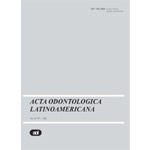
Impact on oral health-quality of life in infants: Multicenter study in Latin American countries
Fecha de Publicación: Marzo 2022

Referencia
BRAZILIAN DENTAL JOURNAL. Ed. Fundação Odontológica de Ribeirão Preto. Brasil. Vol. 33, Nº 2, pag. 61-67.
Resumen general
To assess the impact of oral conditions on oral health-related quality of life (OHRQoL) in infants in ten Latin America countries (LAC). A cross-sectional study was conducted with 930 pairs of 1-to-3-year-old children/parents from 10 LAC, as a complementary study of the Research Observatory for Dental Caries of the Latin American Region. The scale ECOHIS, previously tested and valid in ten countries, was applied to parents/caregivers of children to measure OHRQoL. Statistical analysis included descriptive data analysis and one-way analysis of variance (ANOVA-One-Way) were performed to compare age groups with OHRQoL. Bootstrapping procedures (1000 re-samplings; 95%CI Bca) were performed. The mean scores of the ´Child Impact´ section in the LAC was 4.0(±8.3), in the ´Family Impact´ section was 2.0(±4.0), and in overall ECOHIS score was 6.0(±12.0). In the ´Child Impact´ section, Argentina 10.0(+2.4) and Venezuela 17.8(±17.5) demonstrated mean scores higher than the LAC total data. In the ´Family Impact´ section, the countries with higher mean scores were Argentina 4.9(±2.0), Ecuador 2.1(±3.1) and Venezuela 7.9(±7.8). In the overall ECOHIS score, Argentina 15.1 (±4.1) and Venezuela 25.7(±25.2) has higher mean scores than the values of LAC. There is an association between children´s age and parents´ report of impact on the OHRQoL (p<0.001). Three-year-olds had a higher mean when compared to one- and two-year-olds, both in the Impact on the Child and Impact on the Family (p<0.001) sections, as well as in the overall ECOHIS (p<0.001). In conclusion, there are differences in OHRQoL among Latin American countries, impacting older children more significantly.



